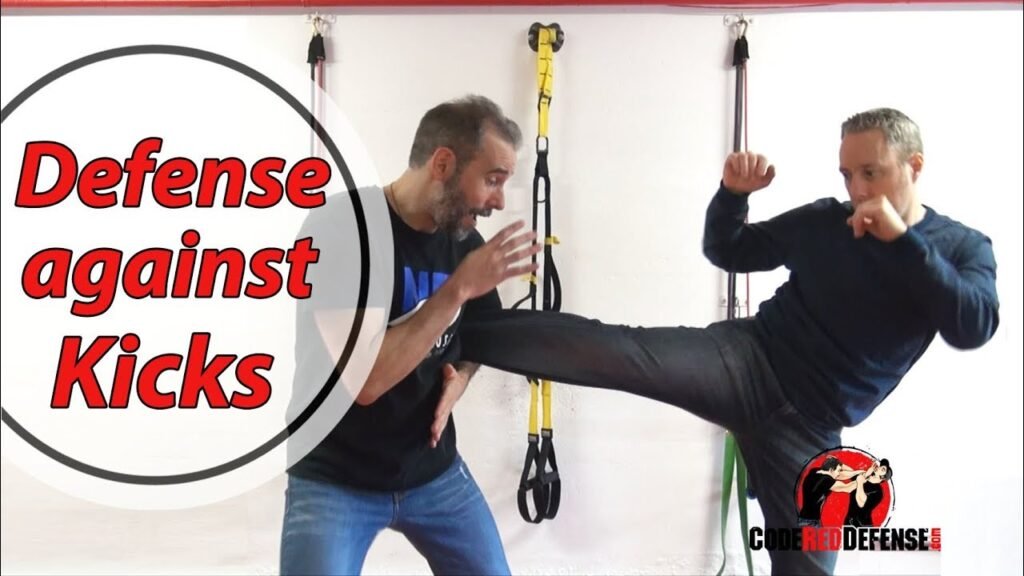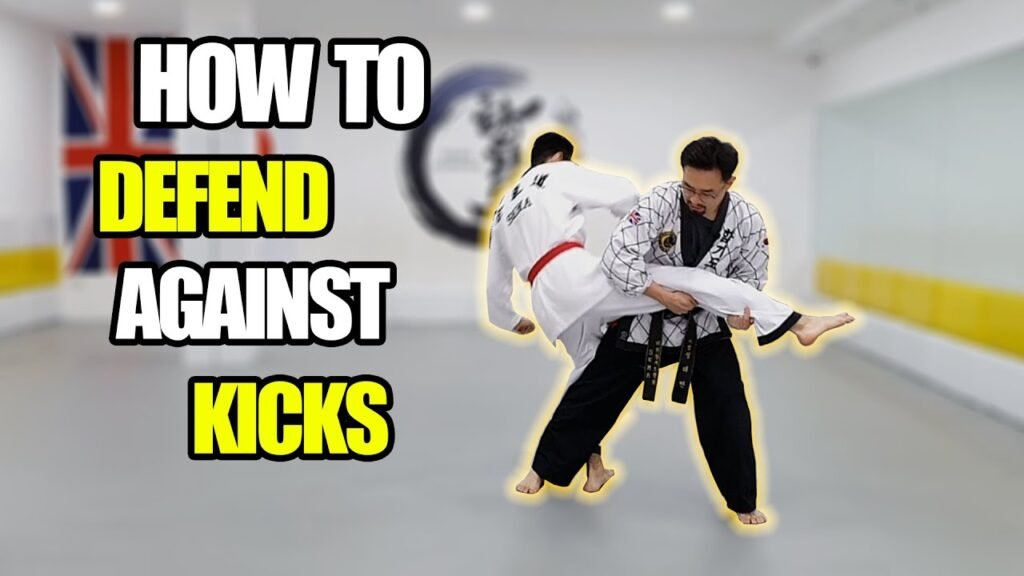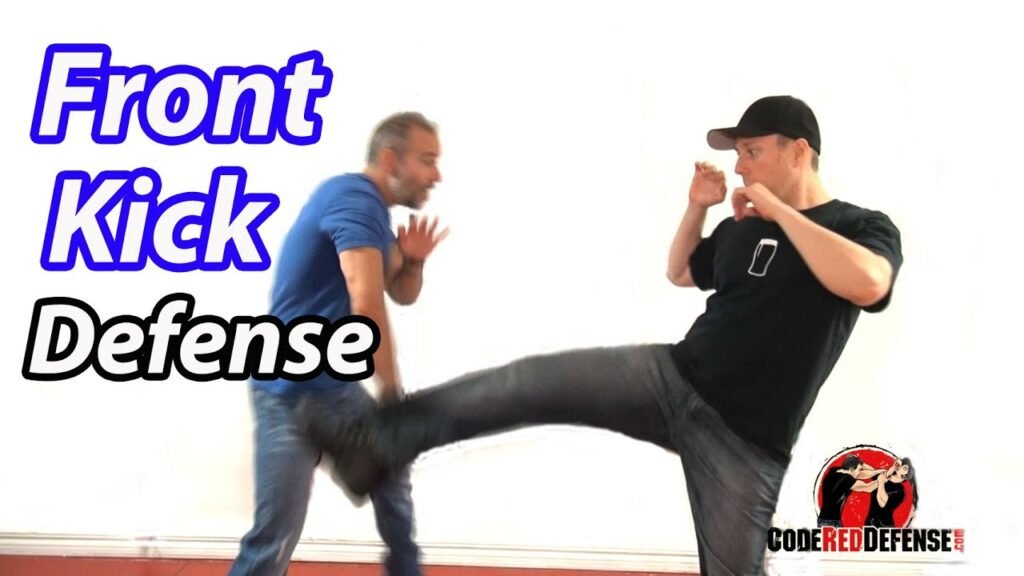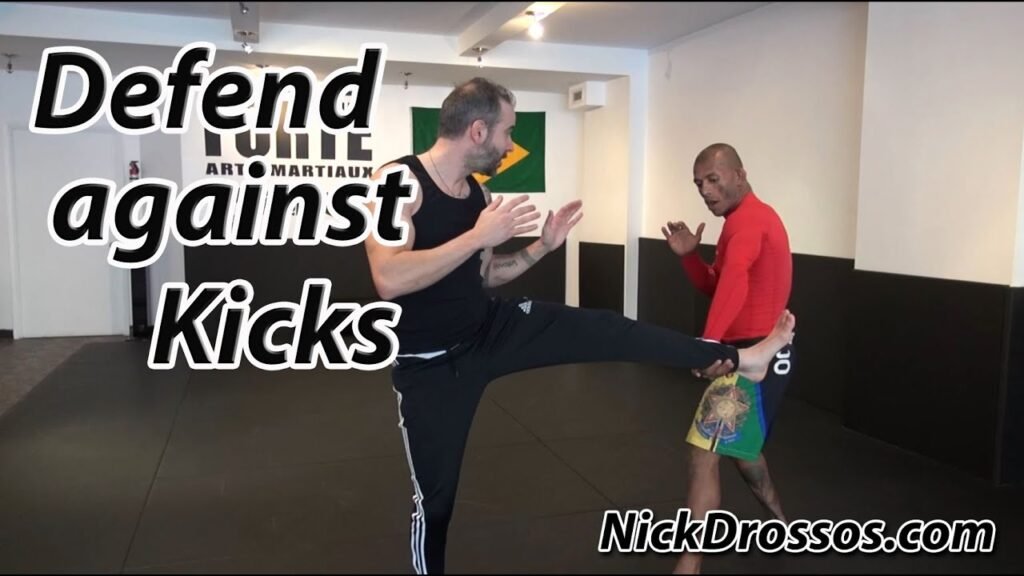Have you ever found yourself in a situation where you needed to defend against powerful kicks? Whether you practice martial arts or simply want to feel more confident in self-defense, learning advanced techniques to defend and neutralize kicks is essential. In this article, we will explore some effective and innovative strategies that will not only help you block and counter kicks but also enhance your overall defensive skills. From incorporating evasive footwork to utilizing strategic hand strikes, these advanced techniques will give you the edge you need to protect yourself in any high-intensity situation. Prepare to take your defense to the next level!

Head movement
Slipping and ducking
One of the most essential techniques in defending against kicks is the ability to slip and duck. By mastering the art of head movement, you can effectively evade kicks and avoid getting hit. Slipping involves moving your head to the side, just enough to avoid the incoming kick, while ducking involves bending your knees and lowering your head to avoid high kicks. These techniques require agility and quick reflexes, but with regular practice, they can become second nature.
Rolling under kicks
Another effective technique for evading kicks is rolling under them. When an opponent throws a high kick, you can roll your body under it by bending at the waist, tucking your head in, and rotating your torso. This allows you to not only avoid the kick but also puts you in a favorable position to counterattack. Rolling under kicks requires good flexibility and timing, so be sure to practice it diligently.
Using bobbing and weaving techniques
Bobbing and weaving is a classic technique used in various combat sports, including kick defense. By bobbing, you move your upper body up and down in a controlled manner, making it difficult for your opponent to land a clean kick. Weaving involves moving your upper body side to side, effectively dodging kicks. By combining bobbing and weaving, you create unpredictable movements that make it challenging for your opponent to anticipate your next move. Practice these techniques regularly to enhance your overall kick defense.
Footwork
Maintaining proper distance
Maintaining the right distance is crucial in kick defense. By staying at the appropriate range, you can neutralize your opponent’s kicks and keep yourself safe. Too close, and you risk getting hit, while being too far away won’t allow you to counter effectively. Practice finding the perfect distance by moving in and out during training sessions. This will sharpen your awareness of kicking range, allowing you to position yourself optimally when defending against kicks.
Sidestepping kicks
Sidestepping is a valuable footwork technique when it comes to kick defense. By moving sideways, you can evade kicks while staying within striking distance. When you see an opponent launching a kick, quickly step to the side, creating an angle that makes it difficult for them to land the kick. Sidestepping also enables you to set up counters, as it disrupts their balance and opens up opportunities for attack. Practice this footwork technique to become a master at neutralizing kicks.
Pivoting to create angles
Pivoting is a footwork technique that allows you to create angles for both defense and offense. When an opponent throws a kick, pivot on the balls of your feet, rotating your body and changing your angle. This movement not only avoids the kick but also sets you up for a counterattack. Pivoting creates a dynamic situation where you can quickly move in and out of your opponent’s range, keeping them off balance. Incorporate pivoting into your training drills to enhance your footwork and kick defense.
Blocking
Basic blocking techniques
Blocking kicks is an essential skill in kick defense. There are several basic blocking techniques you can employ to minimize the impact of kicks. The most common blocking technique is the shin block, where you raise your leg and position your shin to absorb the incoming kick. Another technique is the forearm block, where you use your forearm to shield your body from kicks. Additionally, the high block can be used to protect yourself against head-level kicks. Regularly practice these basic blocking techniques to develop strong and reliable defenses against kicks.
Advanced blocking techniques
In addition to the basic blocking techniques, advanced blocks can provide you with more effective ways to defend against kicks. For example, the catch and sweep block involves catching the opponent’s leg and sweeping it away, destabilizing them and preventing the kick from landing. Another advanced technique is the cross-arm block, where you cross your arms in front of your body to create a solid barrier against kicks. These advanced blocking techniques require precise timing and coordination, so be sure to practice them regularly under the guidance of an experienced instructor.
Combining blocks with counters
Blocking should not be seen as just a form of defense; it can also be used as a stepping stone for counterattacks. By combining blocks with counters, you can effectively neutralize your opponent’s kicks and launch effective strikes of your own. For example, after blocking a kick with a shin block, swiftly counter with a powerful roundhouse kick or a punch. The key is to seamlessly transition from defense to offense, catching your opponent off guard. Practicing blocking and countering in combination will significantly enhance your overall kick defense skills.
Parrying
Redirecting kicks with hand parries
Parrying kicks involves redirecting the trajectory of the kick, making it miss its intended target. Hand parries are effective for redirecting kicks aimed at the upper body. When an opponent throws a roundhouse kick toward your midsection or head, use your lead hand to redirect the kick by lightly slapping or pushing it to the side. This subtle movement can throw off your opponent’s balance and create an opening for a counterattack. Regular practice of hand parries will improve your ability to effectively parry and neutralize kicks.
Using leg parries to disarm opponents
Leg parries are a valuable technique when it comes to defending against kicks aimed at your lower body. By using your own legs to intercept the opponent’s kick, you can disarm them and prevent the kick from landing. For example, if an opponent throws a low kick toward your thigh or knee, you can lift your leg and meet their kick with yours, effectively blocking it. This technique requires good timing and coordination, as well as leg strength and flexibility. Practice leg parries regularly to develop the ability to disarm opponents and protect your lower body.
Counterattacking after successful parries
After successfully parrying a kick, you have a brief window of opportunity to launch a counterattack. Once you’ve redirected the kick using hand or leg parries, quickly follow up with a strike or a series of strikes to catch your opponent off guard. This counterattack can be a punch, a kick, or a combination of both. The key is to capitalize on the opening you’ve created by successfully parrying the kick. Regularly practice parrying and counterattacking to develop the ability to seamlessly transition from defense to offense.

Evading
Using the slip and roll technique
The slip and roll technique allows you to evade kicks by moving your body in a fluid and unpredictable manner. When an opponent throws a kick, you can slip by moving your body slightly to the side, just enough to avoid the kick without moving too far away. The roll involves bending your knees and waist, allowing the kick to pass over you while maintaining your position. By incorporating the slip and roll technique into your kick defense arsenal, you can effectively evade kicks and create opportunities for counterattacks.
Utilizing side stepping and shuffling
Side stepping and shuffling are footwork techniques that can be combined with evasive movements to neutralize kicks. By quickly stepping to the side or shuffling your feet, you can effectively dodge kicks while staying within range to counterattack. These movements disrupt your opponent’s timing and make it difficult for them to land clean kicks. Additionally, side stepping and shuffling allow you to create angles for counterattacks, as they force your opponent to readjust their position. Regularly incorporate these footwork techniques into your training to enhance your evasive abilities.
Nullifying kicks with quick footwork
Quick footwork is crucial in evading kicks effectively. By developing agility and speed in your footwork, you can nullify kicks by simply moving out of the way. Quick steps, pivots, and short sprints can be used to quickly change your position and evade oncoming kicks. With practice, you will be able to anticipate and react to kicks with lightning-fast footwork, rendering your opponent’s kicks ineffective. Regularly train your footwork drills to improve your speed and agility in kick defense.
Countering
Timing and countering with strikes
Timing is key in countering kicks effectively. By understanding the rhythm and patterns of your opponent’s kicks, you can time your counters to perfection. As the opponent throws a kick, you can launch a strike at the precise moment their leg is extended, catching them off balance and disrupting their attack. The counterstrike can be a punch, a kick, or a combination, depending on the situation. Practice timing and countering with strikes to develop the ability to capitalize on your opponent’s kicks.
Exploiting vulnerabilities in the opponent’s stance
Every stance has its vulnerabilities, and by identifying these weaknesses, you can exploit them when countering kicks. For example, if your opponent has a wide, squared stance, they may be susceptible to sweeps or leg kicks. If they lean forward too much, a well-timed push kick or a quick jab can throw them off balance. By understanding your opponent’s stance and its weaknesses, you can capitalize on these vulnerabilities and launch effective counterattacks. Regularly analyze and study your opponents’ stances to enhance your ability to exploit their weaknesses.
Using feints to create openings
Feints are deceptive movements or strikes designed to trick your opponent and create openings for counterattacks. By throwing a feint before countering a kick, you can bait your opponent into reacting prematurely, leaving them exposed and vulnerable. For example, throw a feint punch to make your opponent raise their guard, and then follow up with a powerful kick or punch to exploit the opening. The key to successful feinting is to make your feints convincing and unpredictable. Regularly practice feints to sharpen your ability to create openings from your opponent’s kicks.

Clinching
Closing the distance to prevent kicks
Clinching is a grappling technique that involves closing the distance between you and your opponent, effectively preventing them from throwing powerful kicks. By moving in close and establishing a clinch, you limit their ability to generate power and distance for their kicks. The clinch can be achieved by grabbing onto your opponent’s upper body, their neck, or their arms. It’s essential to maintain control in the clinch to neutralize any potential kicks they may attempt. Regularly practice clinching drills to become proficient in closing the distance and preventing kicks.
Neutralizing kicks by clinching the opponent
Once in the clinch, you can neutralize your opponent’s kicks by using various techniques. For example, you can control their legs by grabbing their thighs or hips, effectively limiting their mobility and preventing them from throwing kicks. Another technique is to transition into a body lock, which involves wrapping your arms tightly around your opponent’s body, restricting their movement and disrupting their balance. By effectively utilizing clinching techniques, you can neutralize the threat of kicks and control the flow of the fight. Regularly practice clinch work to enhance your kick defense skills.
Takedowns and submissions from the clinch
In addition to neutralizing kicks, the clinch also provides opportunities for takedowns and submissions. By maintaining control over your opponent’s upper body and positioning yourself properly, you can execute various takedowns, bringing the fight to the ground. Once on the ground, you can utilize your grappling skills to secure submissions and finish the fight. Techniques such as trips, sweeps, and throws can be employed, depending on the situation. Incorporate takedown and submission drills into your training to become well-rounded in both kick defense and grappling.
Defensive kicks
Utilizing defensive kicks to intercept attacks
Defensive kicks are a valuable tool in kick defense, allowing you to intercept and neutralize your opponent’s attacks. By executing defensive kicks, you can disrupt their balance and timing, effectively nullifying their kicks. For example, a well-timed teep kick to the midsection can push your opponent back, preventing them from launching their kick effectively. Defensive kicks can also be used to counterattack after neutralizing an opponent’s kick, keeping them on the defensive. Regularly practice defensive kicks to develop the ability to intercept and neutralize attacks effectively.
Using low kicks to disrupt opponents’ balance
Low kicks are an effective means to disrupt your opponent’s balance and limit their kicking ability. By targeting their legs, especially the thigh or calf, you can impair their mobility and make it difficult for them to maintain their stance. Low kicks can cause pain, decrease their mobility, and wear your opponent down over time. Remember to execute low kicks with proper technique and power, aiming for the intended target without telegraphing your movements. Regularly practice low kicks to enhance your ability to disrupt opponents’ balance.
Countering with powerful defensive roundhouse kicks
The defensive roundhouse kick is a powerful counterattack that can be used to neutralize your opponent’s kicks. When an opponent throws a kick, you can quickly raise your leg and execute a roundhouse kick to their exposed midsection or legs. This technique not only neutralizes their attack but also inflicts significant damage. The key to a powerful defensive roundhouse kick is proper technique and timing. Regularly practice this technique to develop the ability to counter kicks effectively with a strong offensive move.

Timing and distance
Anticipating and avoiding kicks with proper timing
Timing is crucial in kick defense, and by developing the ability to anticipate kicks, you can effectively avoid them. By studying your opponent’s movements and patterns, you can begin to anticipate when and how they will throw their kicks. This allows you to move out of the way or block their kicks before they even land. Proper timing requires experience and practice, so regularly spar and train with partners to sharpen your anticipation skills.
Maintaining the right distance to neutralize kicks
Distance management is essential in kick defense. By maintaining the right distance, you can effectively neutralize kicks and prevent your opponent from landing clean strikes. Too close, and you risk getting hit, while being too far away will make it difficult for you to counter effectively. It’s crucial to strike a balance by constantly adjusting your distance based on your opponent’s movements and intentions. Regularly practice drills that focus on distance management to develop a keen sense of the right distance for kick defense.
Understanding the range of different kicks
Each kick has its own range and trajectory, and understanding these variations is vital in kick defense. By studying different kicks and their respective ranges, you can adjust your positioning and reactions accordingly. For example, a roundhouse kick has a wider range compared to a front kick, while a spinning hook kick covers a large area with a specific trajectory. By familiarizing yourself with these ranges, you can anticipate and respond appropriately, effectively neutralizing your opponent’s kicks. Regularly train with partners who have different kicking styles to broaden your understanding of kick ranges.
Training drills
Shadow boxing and kicking drills
Shadow boxing and kicking drills are excellent ways to develop your kick defense skills. By visualizing an opponent and practicing your movements and techniques, you can hone your reflexes and timing. Shadow boxing allows you to focus on your footwork, evasive movements, and blocking techniques without the need for a training partner. Kicking drills, on the other hand, help you perfect your kicking techniques and refine your accuracy. Regularly incorporate shadow boxing and kicking drills into your training to improve your overall kick defense.
Partner drills for practicing defense against kicks
Practicing defense against kicks with a partner is essential to simulate real-life situations. Partner drills allow you to work on your timing, distance management, and technique against live attacks. For example, you can have your partner throw kicks while you focus on evading, blocking, or countering. Additionally, you can practice defensive drills where you take turns attacking and defending, allowing both partners to refine their skills. Remember to prioritize safety and communication during partner drills to avoid unnecessary injuries. Regularly train partner drills to enhance your kick defense skills in a dynamic setting.
Using equipment to improve kick defense
Equipment can be used to enhance your kick defense training, providing realistic and controlled scenarios. For example, focus mitts and Thai pads can be used by your training partner to simulate kicks, allowing you to practice blocks and counters in a dynamic setting. Heavy bags can be utilized to develop power and accuracy in your strikes while also improving your footwork. Additionally, using agility ladders or cones can enhance your footwork and quickness in evading kicks. Incorporate equipment into your training sessions to make them more challenging and effective in improving your kick defense.
By mastering the techniques and strategies outlined in this comprehensive guide, you can become a proficient defender against kicks. Remember to practice regularly, seek guidance from experienced instructors, and always prioritize safety during training. With dedication and hard work, you can elevate your kick defense skills and become a formidable opponent in any combat sport or self-defense situation. Good luck and happy training!


